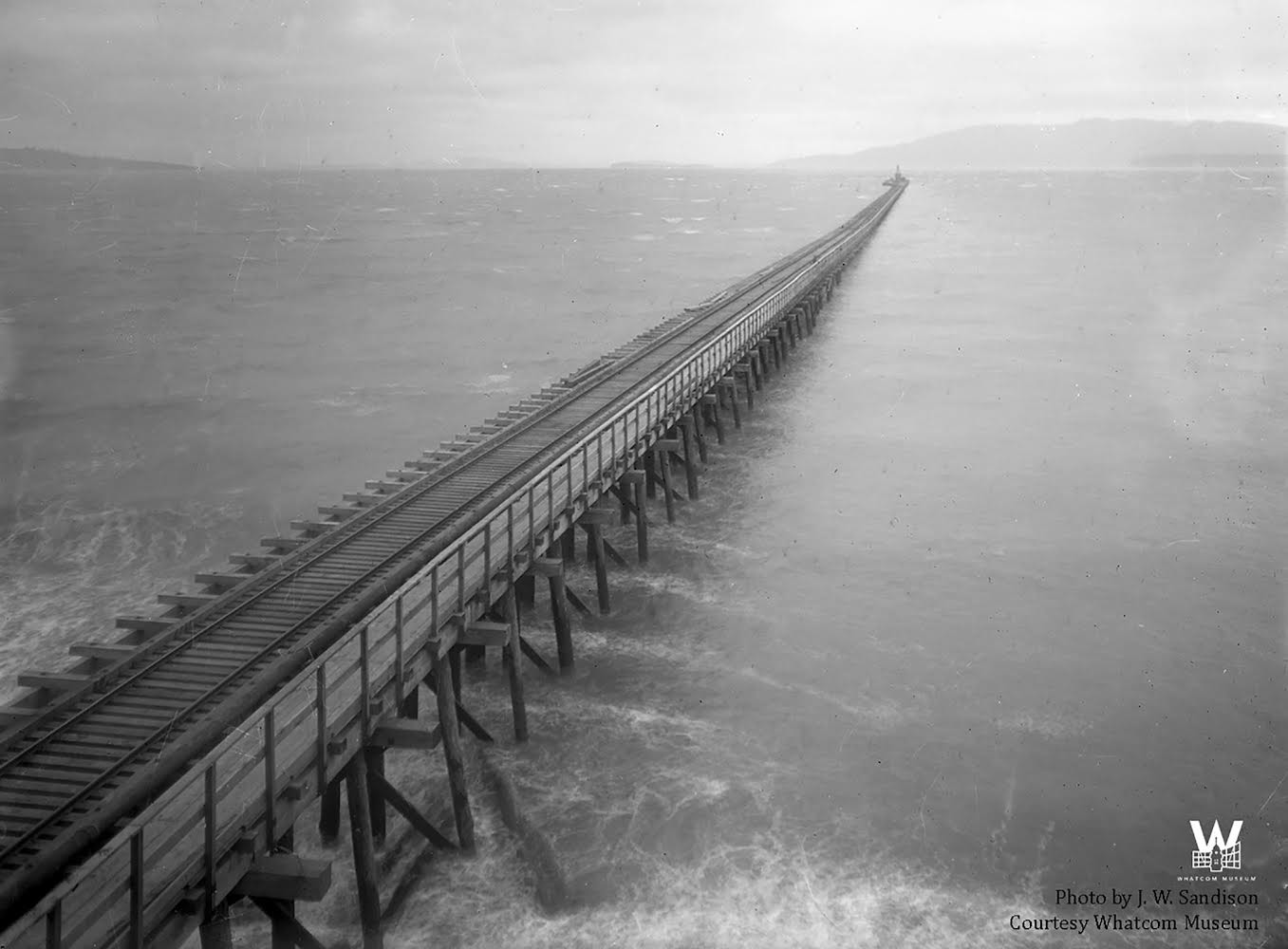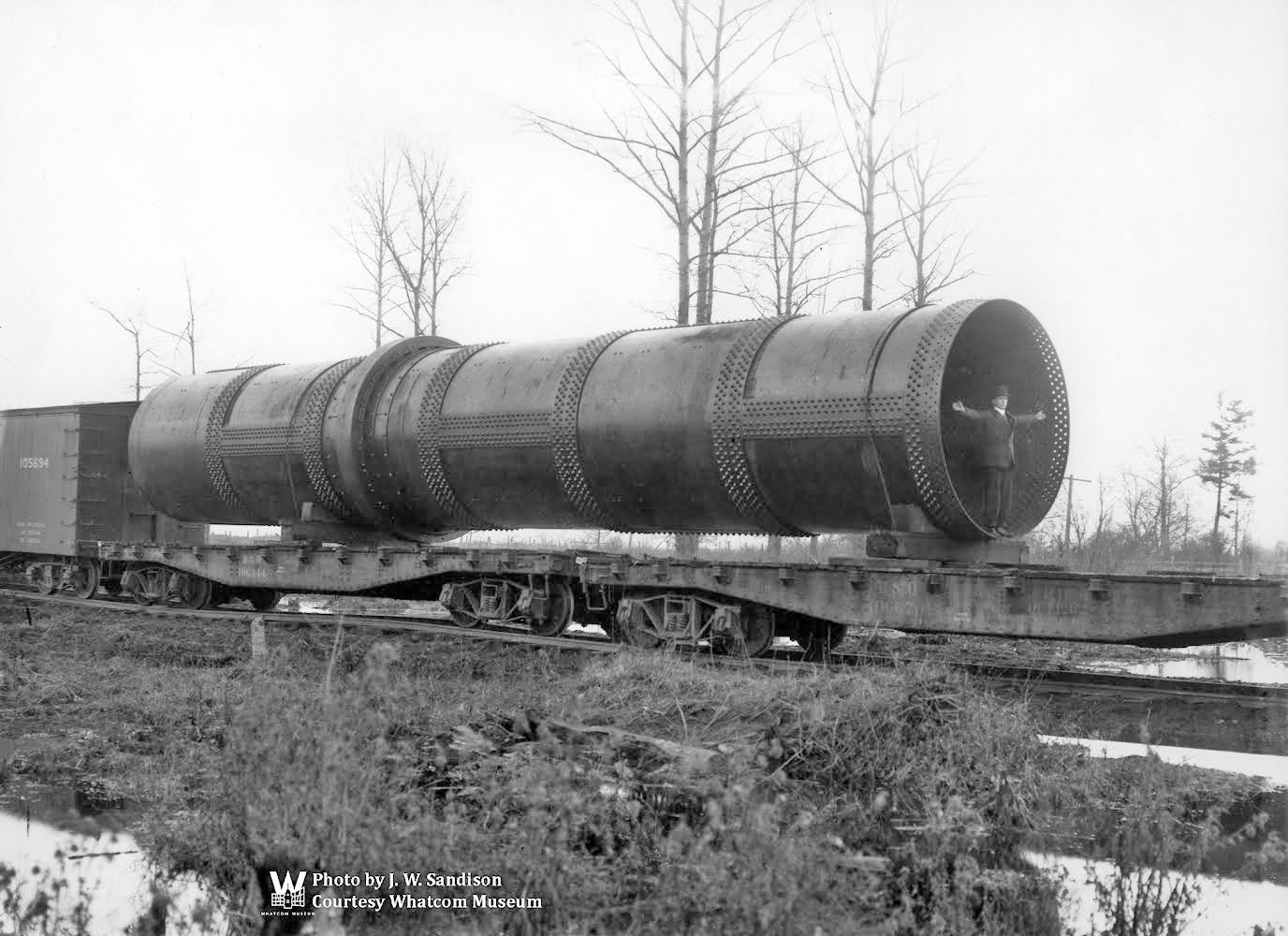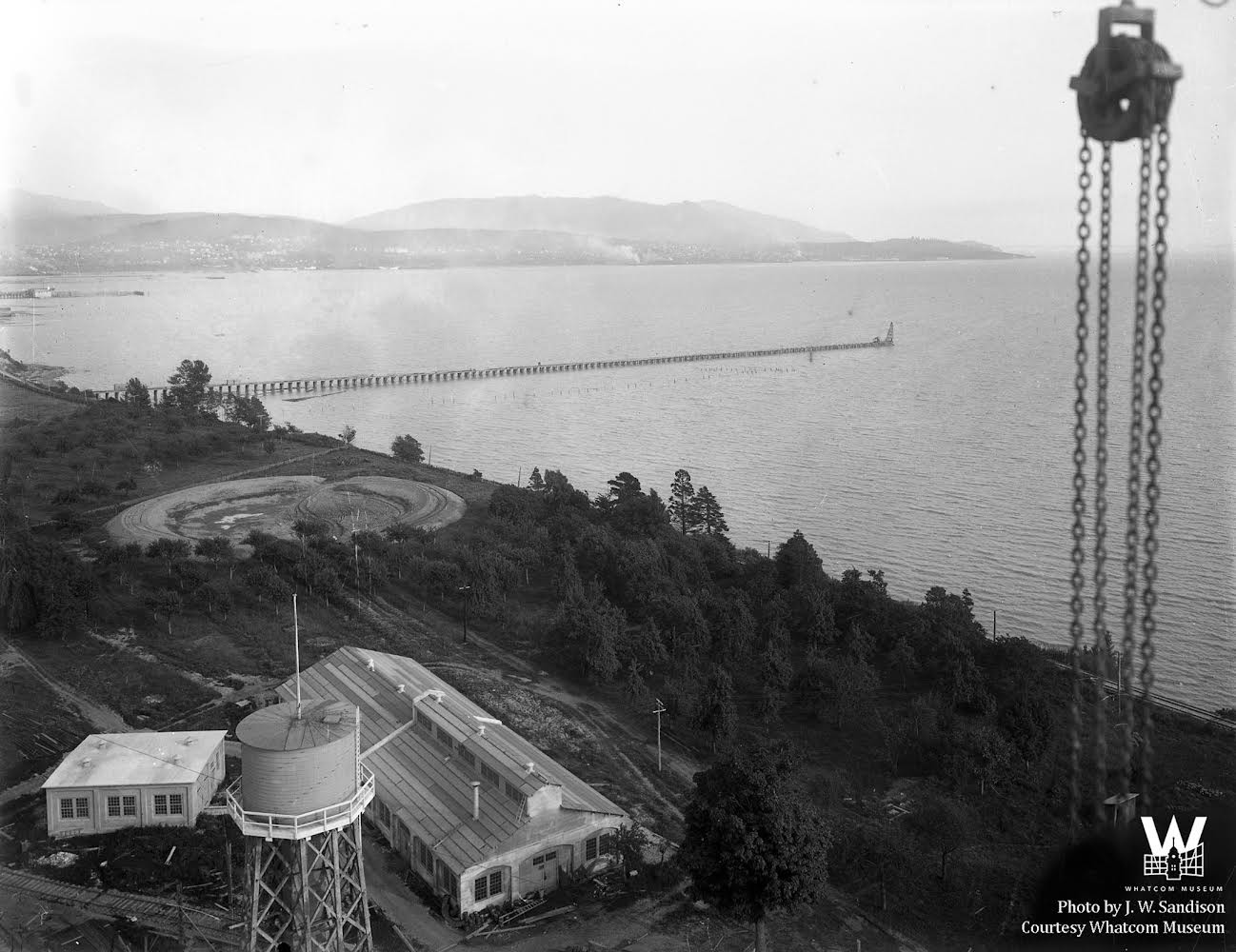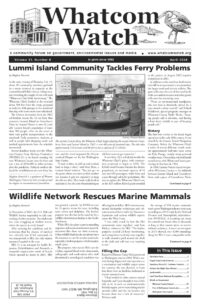
The Olympic Portland Cement Company pier around 1912. The train tracks seem to stretch far across Bellingham Bay.
by Meghan Fenwick
The only thing currently keeping residents and visitors from experiencing a one-of-a-kind view of Bellingham Bay is a gate, a lock and a year’s worth of refurbishing.
This summer, the City of Bellingham Parks and Recreation department is hoping to begin rehabilitation of the 1,200-foot pier at Little Squalicum Park. Once completed, the pier will be open to the public for the first time since its creation in 1912. Gina Austin, parks engineer and project manager, anticipates the opening date in late 2025.
“It’s a view that you really only get from a boat,” said Nicole Oliver, Bellingham’s Parks and Recreation director. “We’re excited about the equity component of having an over-water structure for people who don’t have that.”
The upgrades are made possible by the Greenways Program (1). The program levies property taxes from Bellingham residents to fund the development and upkeep of public trails, parks and open spaces. In November, Bellingham voters approved the fifth property tax in the program’s history, amounting to 41 cents per $1,000 assessed valuation.
Greenways allocated $1.5 million to this phase of renovations, including safety measurements like handrails, light-penetrable walkways and low-level lighting.The lights will be powered by off-the-grid solar and wind, complete with wind turbines atop four 30-foot poles. Oliver said the final design is about 90 percent complete, and the city is looking to put the construction up for bid as soon as possible.
Taking a Risk
Oliver has been a city employee for 25 years (in 1995, 1996 and 1997, she edited 10 issues of Whatcom Watch and wrote 18 articles) and was appointed director in 2020. She recalls the first Greenways Advisory Committee identifying the pier as a community asset in 1996, and former mayors Seth Fleetwood and Kelli Linville pushing the parks department to pursue this project. Originally built in 1912 to withstand the weight of a locomotive and freight cars transporting cement products, the structure is sound, and only requires minimal construction to transform it into a must-visit for sightseeing excursions.

An adult man’s wingspan stretches the diameter of a large kiln being delivered to the Olympic Portland Cement Company plant, circa 1912.
Complicating this goal was a long list of permits, overlapping jurisdictions as well as environmental and safety assessments.
“We did not have the permits to make it available to the public when we acquired it, but we really felt like we had a solid foundation between the approved master plans and the community intentions that were articulated over time with the various levies,” Oliver said. “We had the ability to create a public over-water amenity out of an existing, sturdy and safe structure.”
Lehigh Northwest Cement Company donated the pier to the city in November 2021, and took on the demolition of the last 600 feet. This section sat in the Washington Department of Natural Resource’s tidelands, and both the city and Lehigh made the well-informed assumption that DNR would not renew their lease, according to Oliver. Seventy-five years of use and exposure to the elements left that section unusable.
After the pier undergoes the first phase of construction and is open to the public, the city plans to do further renovations. This may include wrapping or replacing pillars with steel as some are no longer needed or worn out. All construction on the water is restricted to August through February while salmon make their way to the ocean. Funding for this round may come from park impact fees or state grants. For the park at large, the city hopes to expand parking and add a restroom facility in the future.
“If you think about the old ferry terminals where big wooden structures caught the ferries, these things last for a long time, but they do need to be upgraded periodically,” Oliver said. “Whenever you do in-water work, it needs to meet the best management practices, so we want to do our absolute best.”
Some pilings contained creosote, a chemical that was commonly used to treat wood in the 19th and early 20th centuries. Through environmental impact assessments, the city found the treated pilings were nonpolluting due to their old age, according to Oliver. Sediment surveys also showed that the pier acts as a wave barrier and prevents further erosion to the embankment that hugs Eldridge Avenue.
Reconciling the Past
The Olympic Portland Cement Company first constructed the pier to complement their waterfront cement plant. The shoreline was already littered with docks, piers, and wharfs beginning in the 1880s to expand trade across the Salish Sea. Up-and-coming industries like logging and fishing undertook a dredging operation to make the bay’s famously shallow tidelands accessible for large ships and barges. What is now known as the Little Squalicum pier facilitated the delivery of cement shipments across the country and to Canada. Operations ceased in 1987, and the pier has sat dormant since.
Upstream, the Army Corps of Engineers dredged Little Squalicum Creek in 1931. In the mid-to-late 1930s, the city burned and buried municipal garbage on a 32,000-square-foot area in present day Little Squalicum Park. Across the waterfront, sediment fill from various dredging projects was used to create moorages, marinas and breakwaters. Not only did these practices degrade valuable marine habitat and impede ecological processes, but they left behind toxic contaminants such as petroleum, dioxins and heavy metals.
Washington state’s Model Control Toxics Act has designated 12 cleanup sites on Bellingham’s waterfront, managed by the Department of Ecology, the City of Bellingham, the Port of Bellingham and several other partners.
Over the course of 150 years, Bellingham Bay lost an estimated 282 acres of aquatic land to these practices related to rapid industrialization, according to a 2013 assessment by the city and Coastal Geologic Services (3).

A pile driver awaits retirement at the end of the pier while the Olympic Portland Cement Company wraps up construction in 1912.
Rebuilding With Greenways
The same study identified Little Squalicum Park as one of the last opportunities on the waterfront to restore estuary habitat. Just as the last section of the pier was demolished in January 2023, the Little Squalicum Estuary Project approached the finish line.
The city contracted Glacier Environmental to remove a concrete barrier preventing fish passage and excavate a 2.4-acre estuary. The project restored almost five acres of habitat, reintroduced 1,100 three-spined stickleback and coho salmon to the creek, and concluded in January when a volunteer work party helped plant native vegetation along the perimeter.
The Greenways Program, the Nooksack Salmon Enhancement Association, the Department of Ecology and several other partners funded the project.
Sarah Gardner is a Greenways Advisory Committee member and president of the Birchwood Neighborhood Association. Birchwood is adjacent to Little Squalicum Park, and she has noticed an increase of visitors since the restoration work concluded.
“I am so thrilled that people love Little Squalicum, and that Bellingham invested in the pier and the estuary and are bringing fish and wildlife back,” Gardner said. “We have a lot of healing and regeneration to do with the land and water here, because of its industrial legacy.
“I would love to see more projects like this, and I think they are possible because people fall in love with a place and want to protect it.”
______________
Meghan Fenwick is a graduate of Western Washington University who recently earned her degree in environmental journalism.
References:
1. https://cob.org/gov/dept/parks/greenway
2. https://cob.org/project/lseproject
3. https://cob.org/wp-content/uploads/wria1-nearpreport.pdf
4. https://cob.org/wp -content/uploads/GAC-2022-Strategic-Plan-Final-12-12-2022.pdf




























